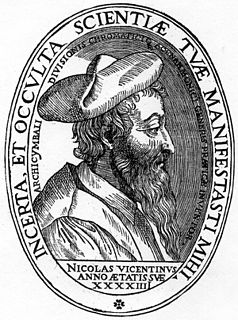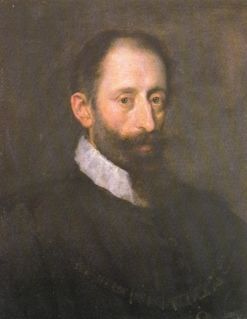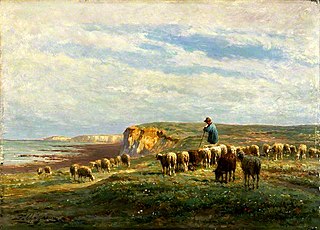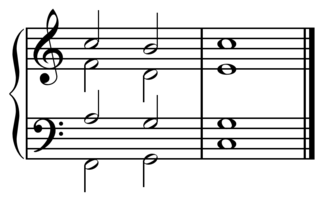
Adrian Willaert was a Netherlandish composer of the Renaissance and founder of the Venetian School. He was one of the most representative members of the generation of northern composers who moved to Italy and transplanted the polyphonic Franco-Flemish style there.
Giaches de Wert was a Franco-Flemish composer of the late Renaissance, active in Italy. Intimately connected with the progressive musical center of Ferrara, he was one of the leaders in developing the style of the late Renaissance madrigal. He was one of the most influential of late sixteenth-century madrigal composers, particularly on Claudio Monteverdi, and his later music was formative on the development of music of the early Baroque era.

Cyprien «Cipriano» de Rore was a Franco-Flemish composer of the Renaissance, active in Italy. Not only was he a central representative of the generation of Franco-Flemish composers after Josquin des Prez who went to live and work in Italy, but he was one of the most prominent composers of madrigals in the middle of the 16th century. His experimental, chromatic, and highly expressive style had a decisive influence on the subsequent development of that secular music form.
A madrigal is a secular vocal music composition of the Renaissance and early Baroque eras. Traditionally, polyphonic madrigals are unaccompanied; the number of voices varies from two to eight, and most frequently from three to six. It is quite distinct from the Italian Trecento madrigal of the late 13th and 14th centuries, with which it shares only the name.

Hans Leo Hassler was a German composer and organist of the late Renaissance and early Baroque eras, elder brother of composer Jakob Hassler. He was born in Nuremberg and died in Frankfurt am Main.
Marc'Antonio Ingegneri was an Italian composer of the late Renaissance. He was born in Verona and died in Cremona. Even though he spent most of his life working in northern Italy, because of his stylistic similarity to Palestrina he is often considered to be a member of the Roman School of polyphonic church music. He is also famous as the teacher of Claudio Monteverdi.
In music, a canzonetta is a popular Italian secular vocal composition that originated around 1560. Earlier versions were somewhat like a madrigal but lighter in style—but by the 18th century, especially as it moved outside of Italy, the term came to mean a song for voice and accompaniment, usually in a light secular style.

Nicola Vicentino was an Italian music theorist and composer of the Renaissance. He was one of the most visionary musicians of the age, inventing, among other things, a microtonal keyboard.
Girolamo Belli was an Italian composer and music teacher of the late Renaissance. He was closely associated with the Ferrara School in the 1580s, having previously studied with Luzzasco Luzzaschi, and was noted for his composition of both madrigals and sacred music.
The decade of the 1540s in music involved some significant compositions.
Giovanni Ferretti was an Italian composer of the Renaissance, best known for his secular music. He was important in the development of the lighter kind of madrigal current in the 1570s related to the villanella, and was influential as far away as England.
Hoste da Reggio was an Italian composer of the Renaissance, active in Milan and elsewhere in northern Italy. He was well known for his madrigals, which were published in several collections in Venice.
Pietro Taglia was an Italian composer of the Renaissance, active in Milan, known for his madrigals. Stylistically he was a progressive, following the innovations of more famous composers such as Cipriano de Rore in Venice, and his music was well-known at the time.
Simon Boyleau was a French composer of the Renaissance, active in northern Italy. A prolific composer of madrigals as well as sacred music, he was closely connected with the court of Marguerite of Savoy. He was also the earliest documented choirmaster at the church of Santa Maria presso San Celso in Milan.
Giulio Fiesco was an Italian composer of the Renaissance, active in Ferrara, known for his madrigals. He was the first composer to set the poetry of Giovanni Battista Guarini, the most often-set poet by madrigalists of the late 16th century, and was an important court composer for the rich musical establishment of the Este family in Ferrara.
Benedetto Pallavicino was an Italian composer and organist of the late Renaissance. A prolific composer of madrigals, he was resident at the Gonzaga court of Mantua in the 1590s, where he was a close associate of Giaches de Wert, and a rival of his younger contemporary Claudio Monteverdi.
Francesco Rovigo was an Italian composer and organist of the late Renaissance, active in Mantua and Graz.
Alfonso dalla Viola was an Italian composer and instrumentalist of the Renaissance. He was the principal composer at the Este court in Ferrara for about four decades in the middle sixteenth century, and was renowned as a player of several instruments, including the viola d'arco. While much of his incidental music, composed for court entertainments, is lost, several books of his madrigals have survived. His position as court composer in Ferrara paralleled that of Francesco Corteccia in the competing city of Florence.
Lambert Courtois was a French composer, trombonist, and singer of the late Renaissance, active in Italy and Ragusa.














